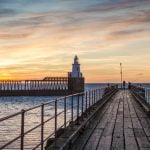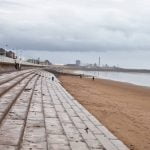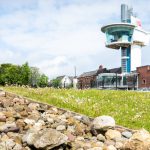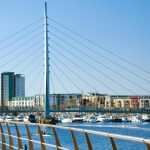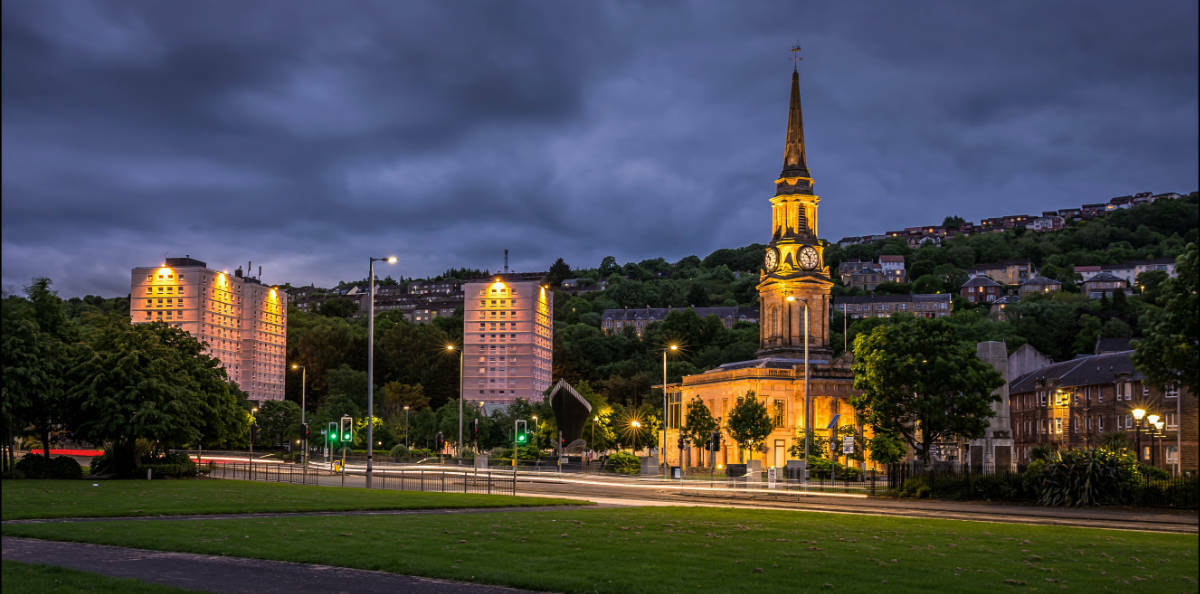
Want to visit the town on the mouth of the Clyde? Here’s all you need to know.
The placement of Port Glasgow is a little bit strange. It’s about 20 miles to the east of Glasgow itself but was constructed by the city in the late 1700s to give them a port nearer to the sea. The River Clyde wasn’t deepened until after the industrial revolution had started. So, in the 1700s Port Glasgow would have been the main receiving port for a fast-growing Glasgow. Merchants transported goods along the Clyde into the heart of Glasgow, using Shire Horses to pull the boats.
You will be hard-pressed to find a Shire Horse by the Clyde now. In fact, the breed nearly went extinct at one point, but that’s a different story. Today we’re focused on Port Glasgow and whether it will make a good destination to visit with your family. Here’s everything you need to know about Port Glasgow, including what the best things to see and do there are.
The Early History of Port Glasgow
Let’s just put one thing to bed straight out the gate. It is Port Glasgow and not the Port of Glasgow. Although it might have been the port of Glasgow originally, locals have long since contracted it down to the two words. If you say the port of Glasgow, you sound posh and Glaswegians hate that, so please don’t.
The story of Port Glasgow starts with Newark Castle. Before there ever was a port here, it was a small hamlet that probably existed for hundreds of years before they built the port in the late 17th century.
The town of Newark grew up around Newark Castle. In the old days, people would flock to castles for protection. If the Vikings sailed up the river, they could simply go inside and close the doors, and all be safe. Or so they thought. The area of land was under the barony of Finlaystone, which was in the possession of Clan Cunningham for many years and was later shared by the Clan MacMillan. Both are ancient clans of Scotland. The Cunningham’s originate on the West Coast of Scotland, whereas the Macmillan’s are Highlanders and one of the earliest Scottish clans. The Cunningham’s use Finlaystone Mansion as their seat now, but back to Port Glasgow.
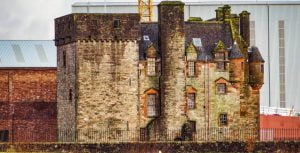
Image: TreasureGalore/Shutterstock.com
Newark Castle was built by a man named George Maxwell who inherited the Finlaystone barony and the parish of Kilmalcolm in 1478. The castle had an outer defensive wall with a tower house and another enclosure inside. It was used by several traders as a place to unload cargo onto the beach. There is deep water here, which the rest of the Clyde didn’t have. In those days, if you tried to go any further inland up the River Clyde you would risk harming your boat in the sandbanks there, which shifted and couldn’t be mapped.
When the Clyde was eventually widened, Port Glasgow became a shipbuilding town, and the remains of the castle were surrounded by different shipbuilding areas. You can still see the restored castle today if you care to visit.
The nearby large town of Greenock started life in 1589 as a small village. It was only four miles west of Newark along the river.
The Building of The Port
In the late 17th century, Glasgow City Council bought a bunch of land in the area. They wanted to build a harbour, and this was the deepest place to do it. Even if it was 20 miles from the city centre. The small town of Newark became Port Glasgow and underwent a period of rapid change. Port Glasgow was set up to be a harbour of sorts. However, Greenock grew up because it was a more desirable place to live. People would live in Greenock and travel to work in Port Glasgow.
There were significant troubles with the Glasgow merchants. There were slave traders in Glasgow. Who profited from tobacco and cotton and other products grew by slave labour in the Americas. If you were to visit Glasgow itself, there is an area called Merchant City. This was the home territory of these merchants. These same merchants fought with the city council over harbour access. They put in a bid to buy land in the Greenock estate, but they were outbid. If they had been successful, we would be telling a quite different story today. Let’s never forget that most of the goods that passed through this port – for hundreds and hundreds of years – were produced by slaves.
Expansion
In 1668 the Maxwell family sold land west of the castle to the council, and they began building. Through these ports and with the council’s tax applied, the Glasgow merchants carried timber, iron, hemp, they carried cotton, mahogany, and the sugar that we put in our tea. Numerous other things were all brought through this port. At first, they were carried upriver by horses pulling tugboats, but later the langdyke was constructed in 1773.
This was the deepening of the river. They hired an architect to come in and design a way to make the river deeper. He built breakwaters all along the Clyde at sections on either side of the river. This forced the main flow of the water to come all the way down the centre, which carved a deeper channel allowing ships to come up themselves. Horses pulled cargo all over Scotland in the canal systems.
The recorded best year of Port Glasgow was in 1830 when the Custom House took 243,349 pounds, three shillings and 1 penny. Greenock erected its own customs house and sales started to tail off. In 1693 the town got an upgrade and in 1780, the first shipyard was built.
Shipbuilding was the meat and veg of the people of the Glasgow area. All the way up until the Thatcher era. If you look to the Scottish people and find an aversion to conservative politics, it comes from the closing of the shipyards. Many, many, many, families were forced into poverty when the shipyards were closed.
In fact, you will find an interesting little modern story about how one shipyard tried to close in 1971/2 and the men showed up to work anyway. They worked for free for more than 400 days, until business picked back up again. It is the biggest example of a work-in run by a union. They were successful, but success was only temporary. There is only one shipyard remaining on the Clyde nowadays, and they build naval warships.
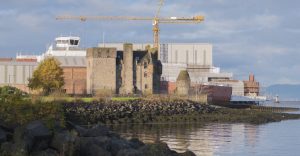
Image: richardjohnson/shutterstock.com
Let’s take an emotional break for a moment and talk about some fun stuff instead.
Fun trivia about Port Glasgow
We always bring our readers the best in fun facts from any given town. Here’s all the gossip we could find about Port Glasgow:
- The first-ever commercial steam vessel in all of Europe was built here in 1812. They named her the comet and they built a replica of her in 1962 to mark its 150th anniversary.
- There were four large sugar houses in Port Glasgow. They would have belonged to the merchants.
- And 1639. The Castle Newark was declared by an Act of Parliament to be “one of the two places for Glasgow for the transportatione of their herring.” Herring was at that time of extreme importance. Don’t laugh, the English loved herring too.
- In 1799 ships experts and merchants set up a fund. They called it the Clyde Society and it would take care of their widows and children in the event of them getting lost at sea.
- Port Glasgow was originally named New Port of Glasgow, but Glaswegians weren’t having that either. We like to contract names if we can. The shorter, the better.
OK, now that we’ve stopped thinking about the sadness of the Clyde shipyards closing, let’s get back to the history of Port Glasgow. Luckily, it’s not an ancient town, so there’s not that much more to get through before we get to the part you’ve all been waiting for: the attractions.
The Industrial Revolution in Port Glasgow
They built the church in 1718 to account for the parish. it was described as barely able to hold 800 people. The town began to outgrow its boundaries in the 1750s. It was extending into the nearby village, which was owned by the Barony of Hamilton.
The town got its own municipal government in 1775 when 13 councillors were elected from the local families. These were known as Baillies. They set up their police force, managed affairs of the town, collected taxes and ran the harbour. In the year 1700, Port Glasgow had only 400 inhabitants. By 1801 they had 4565 inhabitants. The Custom House records are interesting. They detail coal and fish, coffee and rum, and even West Indian produce. They were bringing in goods from fisheries in Nova Scotia.
The town had three different schools before 1825 and in 1808 there were 106 pensioners claiming money from the kirk. The schools taught writing, arithmetic, geography, mathematics, English, reading and grammar, Latin, and Greek. Over 200 pupils attended the schools. Most attended for free, but if your parents could afford it, they paid the fee.
In 1833 Port Glasgow was its own burgh. Not long after that they deepened the River Clyde and added in a railway station. They then built a motorway. Port Glasgow was no longer needed as a port because the ships could go directly to Glasgow. Instead, it became a shipbuilding town. At one point, Glasgow was the 5th largest shipbuilding producer of steel ships in the world.
Modern Era Port Glasgow
The town went through a period of wealth and prosperity right up until the 70s and 80s. In 1937, a park named Coronation Park opened on the former site of the West Harbour. In the 1960s, it was extended into the old East Harbour and the wet dock area. The new A8 dual carriageway runs through here. The park is built on the remains of the dockside warehouses. The government introduced Scottish Industrial Estate plans in the 40s and in the 60s and 70s this soaked up some of the fallout from the failing shipbuilding industry. The town council added another industrial area in the 1990s.
The population of Port Glasgow is 20% less than it was in the 1980s. When the shipbuilding industry closed, it pushed hundreds of families into poverty. The town earned its nickname of “The Dirty Wee Port” from surrounding Greenock and Gourock neighbours about this time.
Modern Port Glasgow is deceptively beautiful. Just because it was an industrial area doesn’t mean that it’s not nestled in the middle of some fantastic scenery. It is backed by hills and fronted by the sea. On a sunny day, you can see across the river to Dunbarton and all the way out to the Isle of Arran, on the West Coast of Scotland. You go to visit expecting an industrial area with a harbour and busy traffic and instead you find this quiet, picturesque town, which makes for some great summer days.
Let’s run through some of the famous people to have come from Port Glasgow and then we can move on to those attractions you’ve been waiting so long to hear about.
Famous people from Port Glasgow
It seems that the further we get from London, the less famous people are on the list. Nevertheless, we have tried to find the most famous people to come from Port Glasgow for your amusement. Here are the Five Minutes Spare favourites:
- Lots of footballers, including Hugh Bolton, John Boag, George Anderson, Jack Gordon, Stephen Kelly, to name but a few.
- James Dykes Campbell who was a) a hated Campbell and b) Samuel Taylor Coleridge’s editor.
- Actor James McAvoy is a Port Glasgow man.
- Harry McNeish, another interesting historical side note. He was the ship’s carpenter for Ernest Shackleton’s 1914 trans-Atlantic voyage.
- Ross McCall, from Band of Brothers.
- The guy behind post-war plastic surgery, John James McIntosh Shaw, was a Port Glasgow guy.
So, a few genii, lots of footballers, and some actors. That’s a good show for a town with less than 20,000 people.
Top attractions in Port Glasgow
So, does Port Glasgow make a good staycation destination? Of course, it does. It’s 20 miles outside the city centre, based on the coast and has some stunning sea views. Here are some of the other top attractions of Port Glasgow.
Historical sites and landmarks
Make the trip to Newark Castle. Much of the existing structure was built in the 12th century, although it was updated in the 1600s. Historic Scotland restored it and you can go in and climb the tower. We recommend you do so because the views of the Hills, harbour and sea are spectacular. It is surprising that this castle remains given that it was once surrounded by warehouses and shipbuilding yards. In fact, as you can see from the pictures above there are plenty of industrial fixtures around it. Still, get its good side and it’s definitely a picture-perfect place. Ideal for those Instagram shots.
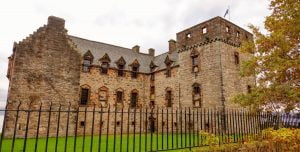
Image: TreasureGalore/Shutterstock.com
Port Glasgow isn’t that old of a town, so the other items in this category are mostly landmarks. You can find the replica of the comet (that first steamship) in the centre of town. It has been standing there exposed to the elements since 1962. Town occupants are always fundraising to try and have it restored.
If statues and sculptures are your things, then you can also find the sculpture of the Endeavour in Port Glasgow. This sculpture is an imitation ship which you will find in front of the Port Glasgow Town Hall. Another excellent photographic area as you can see below:
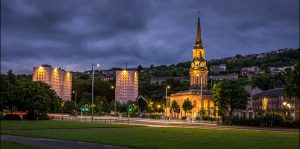
Image: Zoladkowski Bogdan/Shutterstock.com
Galleries and museums
Port Glasgow is severely lacking in museums. If you are in the area, we recommend that you visit this tobacco warehouse in Greenock. Inverclyde also has the McLean Museum and Art Gallery. We would absolutely recommend that you take the trip back into town along the River Clyde and visit the Riverside Museum. You will recognise it by the tall ship parked outside. Since you are in the Glasgow area. It would be worth your while taking a trip to the Kelvingrove art gallery.
Outdoor attractions
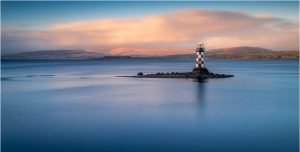
Image: Zoladkowski Bogdan/Shutterstock.com
There is a little lighthouse on the promenade that people call Lighthouse Island. This was colloquially known as the perch light back in 1881. The council painted the lighthouse in a black and white chequered pattern. The combined Promenade and lighthouse make for a pleasant walk.
Locally, the best park is Coronation Park which as the name suggests was opened in 1937 to celebrate KGI’s accession to the throne. It contains plenty of statues, sculptures, and even a drinking fountain. There are also clues to the town’s industrial history and on a sadder note a memorial to the Clyde boating tragedy which took place in 1947.
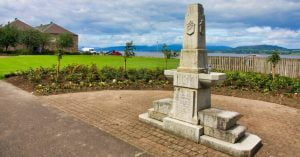
Image: TreasureGalore/Shutterstock.com
Sports and recreation
There are lots of golf clubs in Scotland so take your pick. Port Glasgow Golf Club is closest but you are right outside the city. You have access to any course you like except St Andrews, which is farther north.
You will find the Parklea Community Sports Facility between Port Glasgow and Greenock. You’ll also find the Finlaystone Country Park out that way, which is a great place to take the kids for a day in nature.
We couldn’t miss out the many football clubs in the area. There’s the Port Glasgow Juniors, the Upper Port Glasgow Social Club, the Greenock Morton Football Club, and a football field between Langbank and Port Glasgow. There are also football clubs that play in real leagues through in the city proper.
Shopping and retail
Greenock has slightly better shopping if you can make that four-mile journey. If not, the industrial area of town has a B&M, a Marks and Spencer, and a Next. You’ll be fine between those. Who needs vegetables? Oh right, there’s a Tesco, you’re fine.
Where to eat, drink and party?
You’ll find the best Indian food in town at the Curry Lounge India Buffet Restaurant. Stuff yer gunnels, as they say here. You’ll find some great Italian food at Louis’s, and a Super Chef for all your fast food needs. Scottish people don’t really have their own cuisine. Deep-fried Mars bar is about as close as it gets. If you visit the nearest fish and chip shop, they will do one for you.
Other notable attractions in Port Glasgow
If you come this far, you’re probably staying in town for more than a week or two. If you’re in town for that length of time, try and see some of the following attractions as well.
- There’s a creepy hand sculpture in the park, one depicting apples, and numerous other statues dotted around.
- The Port Glasgow Cenotaph remembers those from the city that died in the war, though there is a second war memorial, too.
- There are lots of little stretches of beach along the river you can hop onto or off.
Don’t forget that you are just down the road from Glasgow and about an hour from Edinburgh on the train. That’s the good thing about Scotland, nothing is more than an hour or two from anything else.
How to get there?
You are up to speed on all things Port Glasgow, except of course how you get there. It really is quite simple.
By road
Head West out of Glasgow on the A8.
By rail
Head for Port Glasgow train station.
By air
The nearest airport is Glasgow Airport.
By sea
They closed the harbour, but you might still get into the Greenock harbour.
Five Minutes Spare
If you have enjoyed this town guide, then you will be delighted to know that there are hundreds more of them on our website. If you want to support us, you can also give us a follow on social media. We appreciate every like, follow, and share.

